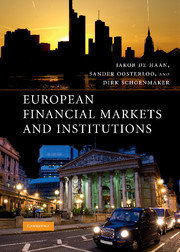Book contents
- Frontmatter
- Contents
- List of Boxes
- List of Figures
- List of Tables
- List of Countries
- List of Abbreviations
- Preface
- Part I Setting the Stage
- Part II Financial Markets
- 3 European Financial Markets
- 4 The Economics of Financial Integration
- 5 Financial Infrastructures
- Part III Financial Institutions
- Part IV Policies for the Financial Sector
- Index
- References
4 - The Economics of Financial Integration
from Part II - Financial Markets
- Frontmatter
- Contents
- List of Boxes
- List of Figures
- List of Tables
- List of Countries
- List of Abbreviations
- Preface
- Part I Setting the Stage
- Part II Financial Markets
- 3 European Financial Markets
- 4 The Economics of Financial Integration
- 5 Financial Infrastructures
- Part III Financial Institutions
- Part IV Policies for the Financial Sector
- Index
- References
Summary
OVERVIEW
This chapter begins by defining financial integration and identifying its drivers. Financial integration may be defined as a situation without frictions that discriminate between economic agents in their access to – and their investment of – capital, particularly on the basis of their location. Not only market forces but also collective action and public action are shown to be driving financial integration.
The second part of the chapter deals with measuring financial integration. Three categories of measures have been used for this purpose. The first category consists of price-based indicators that measure discrepancies in prices or returns on assets caused by the geographic origin of the assets. The second category consists of news-based measures. The underlying idea is that in a financially integrated area, portfolios should be well diversified so that news (i.e., arrival of new economic information) of a regional character has little impact on prices, whereas common or global news is relatively more important. The third category of measures are quantity-based indicators that measure the effects of frictions faced by the demand for and supply of investment opportunities, like cross-border activities or listings, and statistics on the cross-border holdings of investors.
The third part of the chapter gives an overview of the extent to which various financial markets in the EU are integrated. An important reason why the European Union put the creation of a single financial market high on the policy agenda is that it widely believed that financial integration may stimulate economic growth.
- Type
- Chapter
- Information
- European Financial Markets and Institutions , pp. 107 - 134Publisher: Cambridge University PressPrint publication year: 2009



